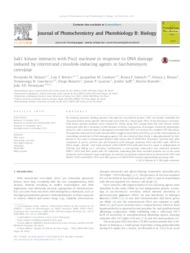Sak1 kinase interacts with Pso2 nuclease in response to DNA damage induced by interstrand crosslink-inducing agents in Saccharomyces cerevisiae.
Sak1 kinase interacts with Pso2 nuclease in response to DNA damage induced by interstrand crosslink-inducing agents in Saccharomyces cerevisiae.
Author(s): MUNARI, F. M.; REVERS, L. F.; CARDONE, J. M.; IMMICH, B. F.; MOURA, D. J.; GUECHEVA, T. N.; BONATTO, D.; LAURINO, J. P.; SAFFI, J.; BRENDEL, M.; HENRIQUES, J. A. P.
Summary: By isolating putative binding partners through the two-hybrid system (THS) we further extended the characterization of the specific interstrand cross-link (ICL) repair gene PSO2 of Saccharomyces cerevisiae. Nine fusion protein products were isolated for Pso2p using THS, among them the Sak1 kinase, which interacted with the C-terminal b-CASP domain of Pso2p. Comparison of mutagen-sensitivity phenotypes of pso2D, sak1D and pso2Dsak1D disruptants revealed that SAK1 is necessary for complete WT-like repair. The epistatic interaction of both mutant alleles suggests that Sak1p and Pso2p act in the same pathway of controlling sensitivity to DNA-damaging agents. We also observed that Pso2p is phosphorylated by Sak1 kinase in vitro and co-immunoprecipitates with Sak1p after 8-MOP+UVA treatment. Survival data after treatment of pso2D, yku70D and yku70Dpso2D with nitrogen mustard, PSO2 and SAK1 with YKU70 or DNL4 single-, double- and triple mutants with 8-MOP+UVA indicated that ICL repair is independent of YKu70p and DNL4p in S. cerevisiae. Furthermore, a non-epistatic interaction was observed between MRE11, PSO2 and SAK1 genes after ICL induction, indicating that their encoded proteins act on the same substrate, but in distinct repair pathways. In contrast, an epistatic interaction was observed for PSO2 and RAD52, PSO2 and RAD50, PSO2 and XRS2 genes in 8-MOP+UVA treated exponentially growing cells.
Publication year: 2014
Types of publication: Journal article
Unit: Embrapa Grape & Wine
Observation
Some of Embrapa's publications are published as ePub files. To read them, use or download one of the following free software options to your computer or mobile device. Android: Google Play Books; IOS: iBooks; Windows and Linux: Calibre.
Access other publications
Access the Agricultural Research Database (BDPA) to consult Embrapa's full library collection and records.
Visit Embrapa Bookstore to purchase books and other publications sold by Embrapa.

